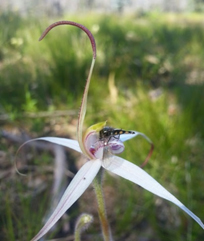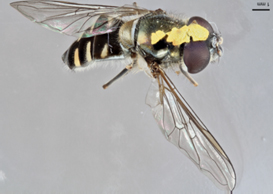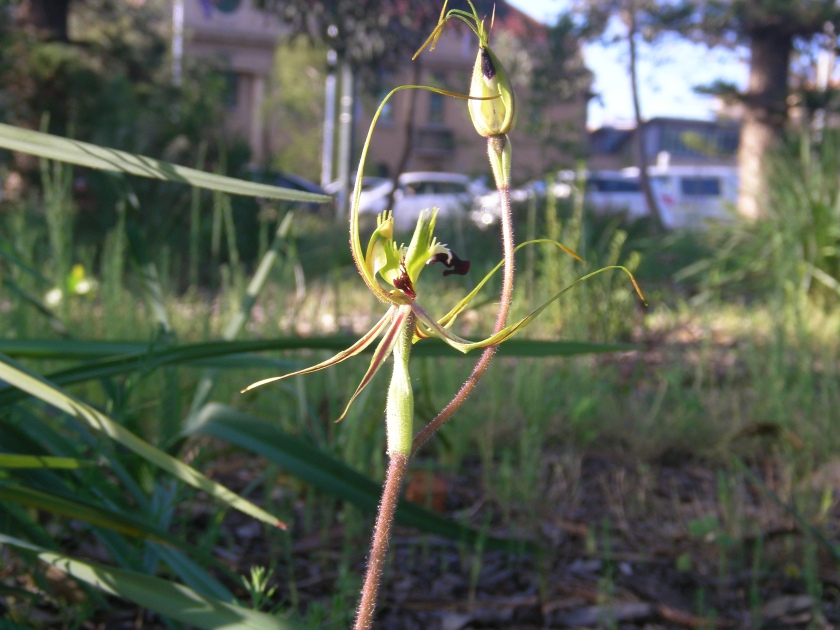Tag: Arachnorchis tentaculata
Protected: Photograph Competition November 2020
2017 October Winning Picture

This month’s theme of “more than six flowers” was interpreted in one of two ways. There were six entries that had six or more plants and the other six entries had six or more flowers, predominately the flowers being on one inflorescence.
The competition was tight with Jane Higgs’ Caladenia tentaculata (syn. Arachnorchis tentaculata) winning by one vote. In South Australia it is known as the King Spider Orchid or Large Green Combed Spider and in Victoria is named the Eastern Mantis Orchid. As it is the largest of the Green Combed Spider Orchids, it is easily identified by its size. But there is variation and sometimes there are patches of small sized plants.
This happened to Rudie Kuiter on one of his orchid forays when he came across of patch of C. parva and small sized C. tentaculata growing together. In his book Orchid Pollinators of Victoria (page 29), he records how he distinguished the differences between the two species – “Except for some minor differences in the labellum they looked much the same. In C. tentaculata the upper margin teeth are longest, whilst in C. parva the central ones are longest. Labellum calli usually run into the red tip on C. parva and just short of the red in C. tentaculata, ...”
Though I could not find these details recorded in any of the field guides I consulted, the differences were obvious when comparing the images of C. parva and C. tentaculata on the Retired Aussies website, www.retiredaussies.com
References:
Kuiter, R. H., Orchid Pollinators of Victoria, Fourth Edition. Aquatic Photographics
Orchids, Insects and Fire
Recently, 10th February 2016, Anita Marquart, PhD student, Adelaide University spoke at the Field Naturalists Society of South Australia. She is a recipient of the Society’s Lirabenda Endowment Fund Research Grant. At the meeting she gave a summary of her research – Orchids, Insects and Fire: Investigating the impacts of prescribe burning on orchid pollinators in Southern Australia. Though she has not finished collating the data she has kindly supplied a summary of her talk with her preliminary findings.
It is always encouraging to see research on our native orchids. They are the Barometer of the Bush, so the more we can discover about them, hopefully the more we will better understand how to manage our native bushland.
Orchids, Insects and Fire: Investigating the impacts of prescribed burning on orchid pollinators in Southern Australia
Anita Marquart, Renate Faast, José M. Facelli, Andrew Austin
School of Earth and Environmental Sciences,
The University of Adelaide, Adelaide 5005 Australia
PhD Project
Summary
Fire is an important ecological factor in Australian ecosystems. Orchids that depend on specific pollinators may be more susceptible to disturbance than more generalist species. Therefore, declines or changes in pollinator communities due to prescribed burns and wild fires could lead to reduced pollination success and consequently declines in orchid populations. The project combines traditional plant and insect ecology with advanced molecular techniques to identify orchid pollinators and assess their response to prescribed burns and wild fires. Insect relevant habitat characteristics (such as floral abundance, vegetation height, presence of logs, litter and standing litter) were assessed and trapping surveys of potential orchid pollinators were conducted in spring, before and after prescribed burns. The effect of both spring burns and autumn burns is being investigated.
Study sites are located in the Adelaide hills with always one burn and one adjacent control site respectively in Kersbrook Native Forest, Millbrook Reservoir, Para Wirra Recreation Park and South Para Reservoir. Some parts of the study sites in Kersbrook and Millbrook were affected by the Sampson Flat Bushfire. Affected sites are used to compare the effects on orchid pollinators after prescribed burns in contrast to wild fires.
Potential orchid pollinators are being identified using DNA barcoding with the mitochondrial cytochrome oxidase I (COI) gene. Sequencing results will be compared with existing databanks and confirmed using morphological identification. As the data accumulates it will build up a reference library of COI barcodes for the species found in the surveys.
The outcome of this research project might help to advise the optimal management of orchid species under fire-managed regimes in the Mount Lofty region of South Australia, as well as more generally in south eastern Australia.

Orchids and their pollinators
Native bees, thyninne wasps and Syrphid flies are known orchid pollinators of South Australian orchid species. Orchids of main interest for this study were Caladenia rigida, Caladenia behrii, Caladenia tentaculata and Glossodia major. Caladenia tentaculata and C. behrii are sexually deceptive orchids and are known to be pollinated by thynnine wasps (Bates 2011). In contrast, C. rigida is food advertising and uses a broad range of bee and fly species, such as native bees and hoverflies (Faast et al. 2009). Glossodia major is a generalist in its pollination strategy and is using small native bees of several genera (Bates 2011, personal observations).
Preliminary findings
Syrphid flies were successfully separated into different species using DNA barcoding methods. Results show that we have two dominating species on our field sites in the Adelaide hills. Both species, Melangyna collatus and Symosyrphus grandicornis are common native Australian species. Both species were caught with orchid pollinia attached and were observed on Caladenia rigida flowers.
First findings suggest that hoverflies don’t seem to be much affected by prescribed burns or bushfires. Syrphid fly numbers vary greatly between the years of sampling, but we did not find a significant impact of prescribed burning or the Samson Flat bushfire.
Statistical analyses for the data on syrphids, native bees and thynnine wasps are currently underway.
Preliminary findings suggest that a range of pollinators are still present on field sites after prescribed burns and even after bushfires. Nevertheless, some specific species might be more sensitive to fires and might have disappeared from the study sites. For example, orchids relying on one species of wasp could be more affected by changes in the abundance of their pollinator after fire, than orchids that are pollinated by a number of different insects.
We will have to analyse our results in more detail to look into the specific species composition for the insect families, especially for native bees and thynnines, rather than looking at overall abundance.

References:
Faast R, Farrington L, Facelli JM, Austin AD (2009). Bees and white spiders: unravelling the pollination syndrome of Caladenia rigida (Orchidaceae). Australian Journal of Botany 57, 315–325.
Bates, R. J. (2011). South Australia’s Native Orchids. Native Orchid Society of South Australia.
From the Journals: A Tale of Two Cities – London & Burnside
The following article written by Robert and Rosalie Lawrence is from the Volume 37 No 9 October 2013 Journal of the Native Orchid Society of South Australia
Orchids and the concrete jungle that makes up a city don’t seem together, particularly the terrestrial orchids. Yet in the heart of one of the world’s most well known capital cities such an orchid was found. On the 19th July 2013, the Telegraph reported that botanists from the Natural History Museum had found in the middle of London a white helleborine orchid (Cephalanthera damasonium) which had not been seen in that region since 1900. It was found in the Queen’s backyard, Buckingham Palace. Despite the building, demolishing, rebuilding, bombing and rebuilding that has been going on for the last 400 years, here is an orchid which has survived to surprise the botanist. (For details see Long Lost orchid found in Buckingham Palace Garden)
It is always heartening to hear good news about orchids but here in Adelaide we have our own encouraging story. Settlement in Adelaide is not as long as in London by a long shot but in our own short time we have managed to clear and cover some very good land with concrete and bitumen. The result has been that much of our native flora has been lost with many of our orchid species being the first to disappear.
In recent years effort has been made to bring back the bush with revegetation projects. This work has not tended to involve the orchids, the work of Heather Whiting and her team of volunteers at Vale Park being an exception. Consequently, any orchids found on such sites tend to be the more robust species principally Pterostylis pedunculata, Microtis sp. and in some cases Linguella sp.
Finding anything else will always be special; but that is what has happened at site where a Shell petrol station stood for decades on the corner of Portrush and Greenhill Roads. After the demolition of the service station the site was an area of bare clay for about a decade. Then in 2003, work began on restoring native vegetation incorporating a mini wetland in an area of 2,000 square metres that was given the name Linden “Bush Garden”. Indigenous flora was sourced from the local region and the site has been kept meticulously weed-free by dedicated workers.
Originally 60 local species were planted with several other species arriving by themselves. Among the latter group are five species of orchids. These include a Microtis species and Pterostylis pedunculata, but the other three are more surprizing – Arachnorchis tentaculata, a small blue-flowered Thelymitra species and a Caladenia (syn Petalochilus) species. How they came to be there is a mystery. The long term viability of them will depend upon the continued maintenance of this unique site.
The City of Burnside should be congratulated both for its foresight and initiative as well as its ongoing support of this project.


